Unit 3 School Life Lesson 13 How Is School Going?表格式教案
文档属性
| 名称 | Unit 3 School Life Lesson 13 How Is School Going?表格式教案 | 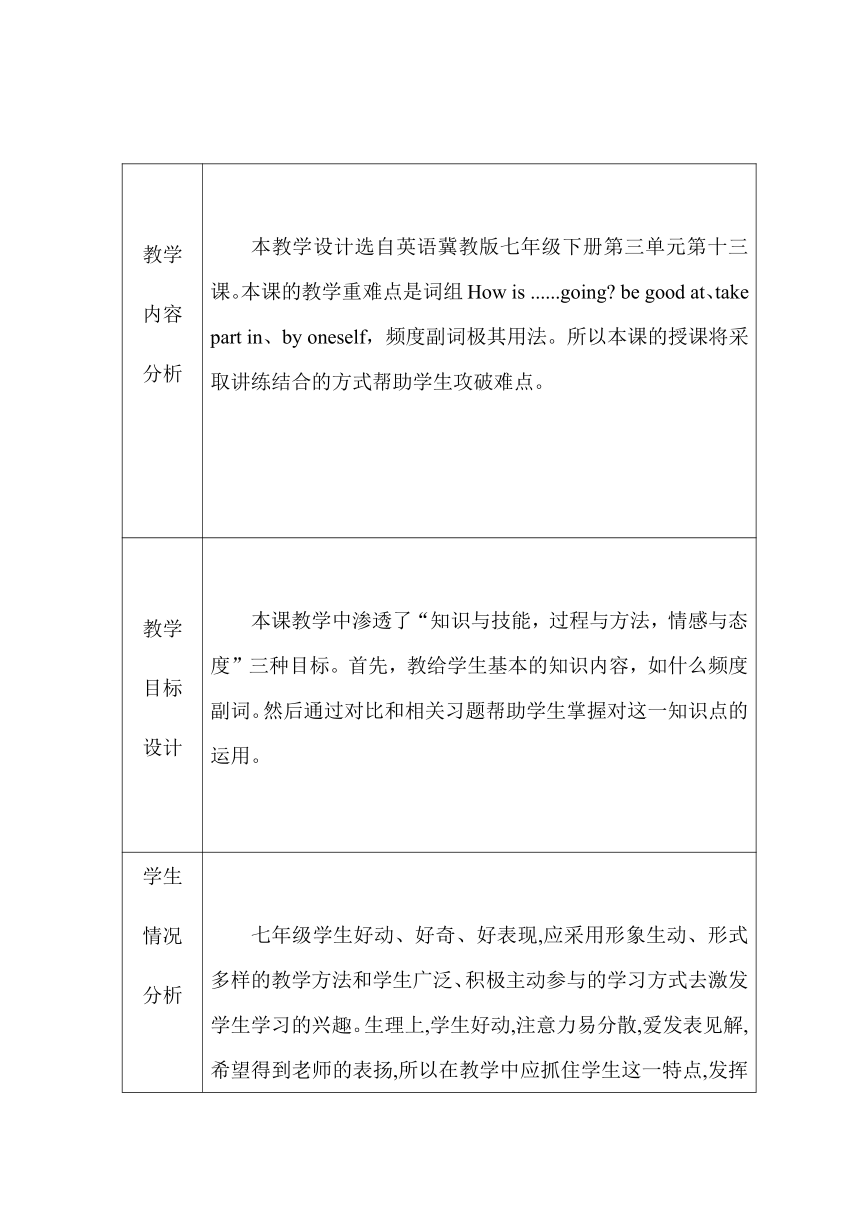 | |
| 格式 | zip | ||
| 文件大小 | 58.0KB | ||
| 资源类型 | 教案 | ||
| 版本资源 | 冀教版 | ||
| 科目 | 英语 | ||
| 更新时间 | 2020-05-07 21:45:37 | ||
图片预览

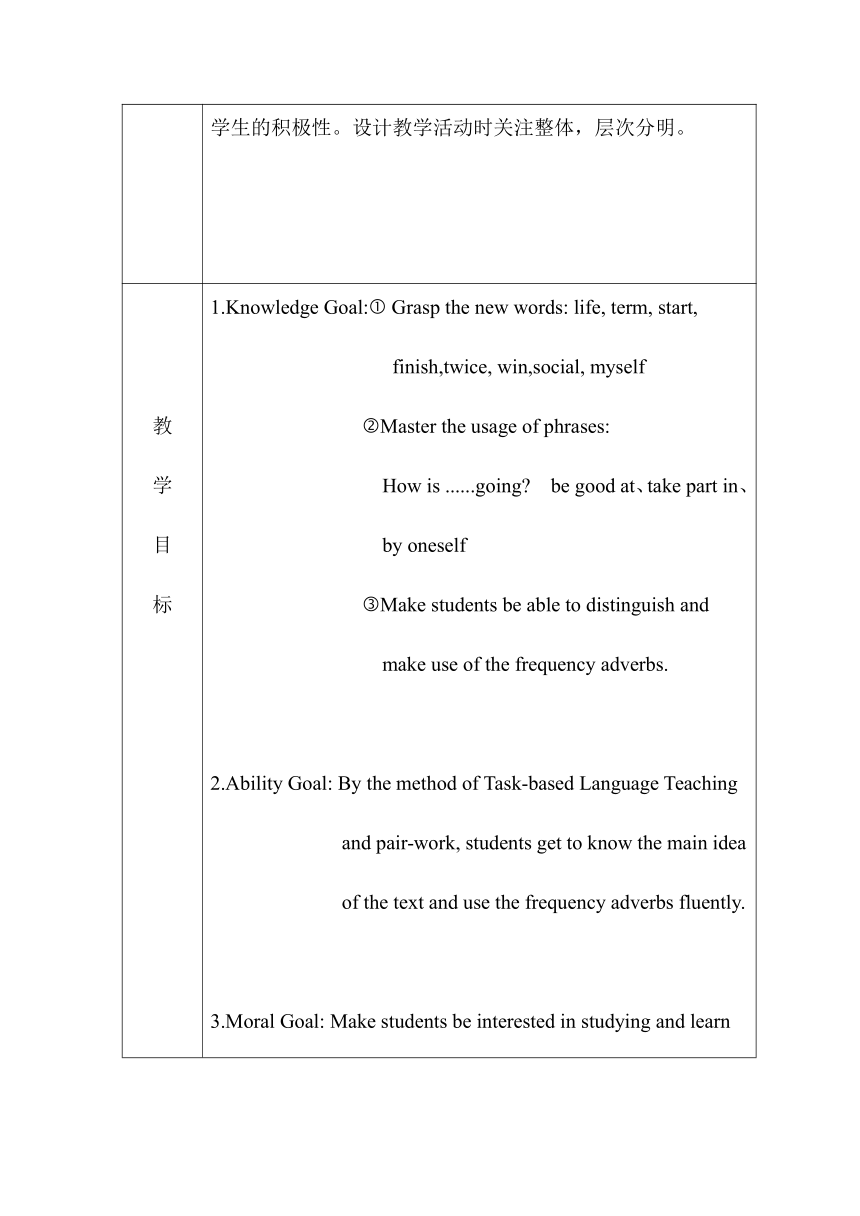
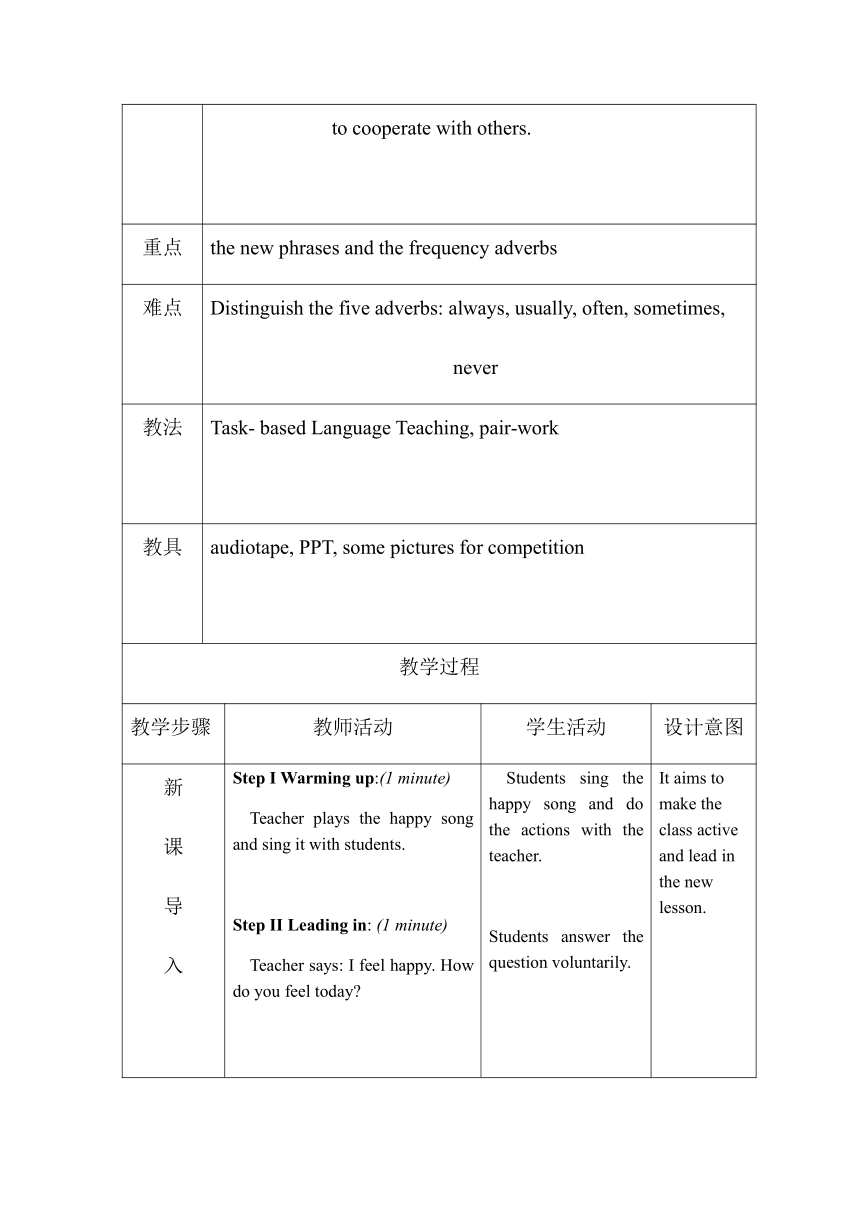
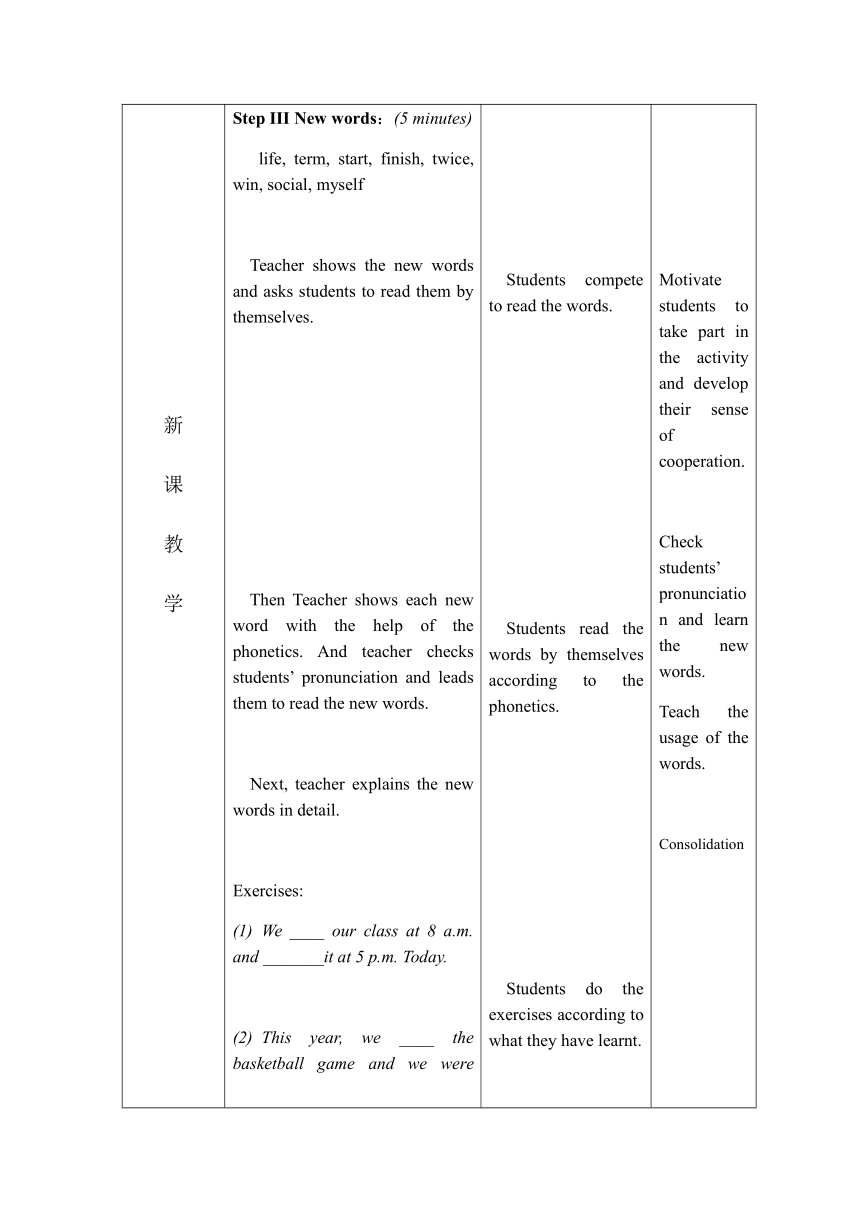
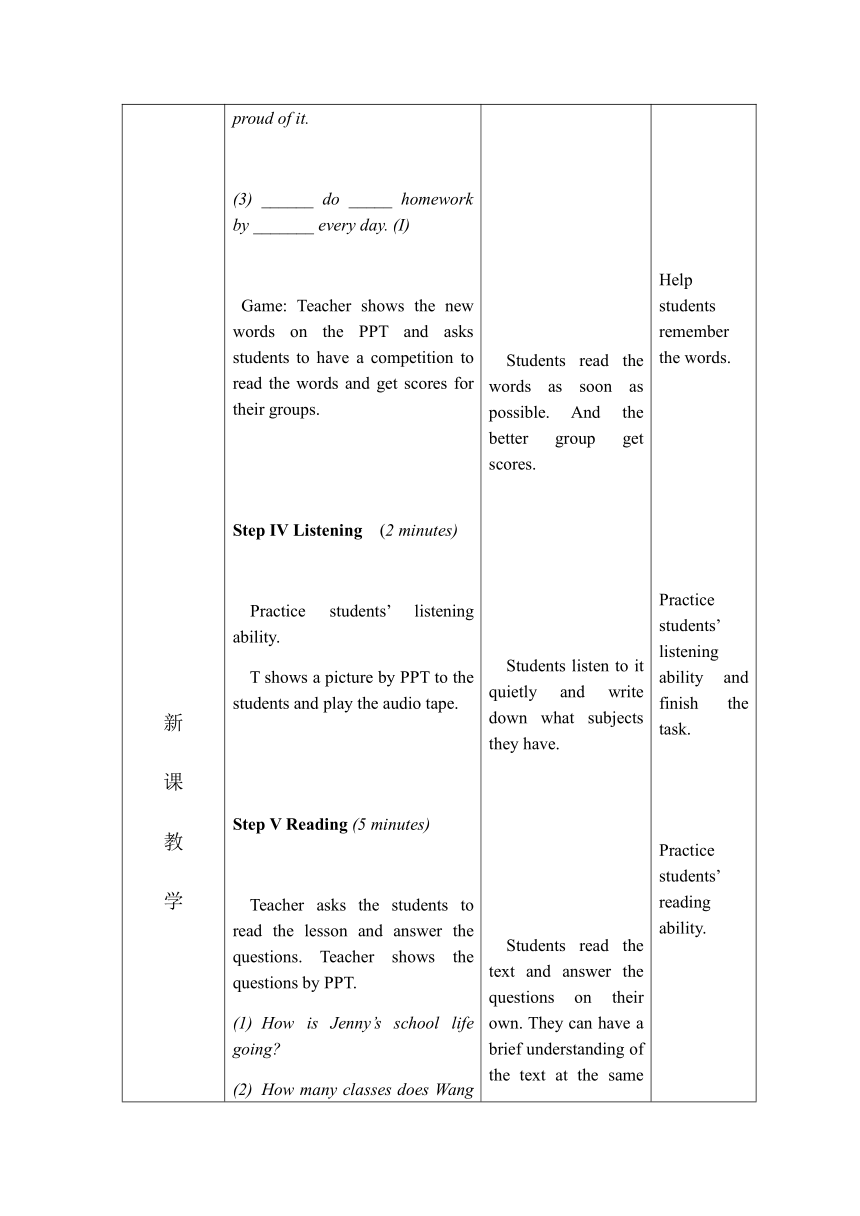
文档简介
教学内容分析 本教学设计选自英语冀教版七年级下册第三单元第十三课。本课的教学重难点是词组How is ......going? be good at、take part in、by oneself,频度副词极其用法。所以本课的授课将采取讲练结合的方式帮助学生攻破难点。
教学目标设计 本课教学中渗透了“知识与技能,过程与方法,情感与态度”三种目标。首先,教给学生基本的知识内容,如什么频度副词。然后通过对比和相关习题帮助学生掌握对这一知识点的运用。
学生情况分析 七年级学生好动、好奇、好表现,应采用形象生动、形式多样的教学方法和学生广泛、积极主动参与的学习方式去激发学生学习的兴趣。生理上,学生好动,注意力易分散,爱发表见解,希望得到老师的表扬,所以在教学中应抓住学生这一特点,发挥学生的积极性。设计教学活动时关注整体,层次分明。
教学目标 1.Knowledge Goal: Grasp the new words: life, term, start, finish,twice, win,social, myself Master the usage of phrases: How is ......going? be good at、take part in、 by oneself Make students be able to distinguish and make use of the frequency adverbs. Ability Goal: By the method of Task-based Language Teaching and pair-work, students get to know the main idea of the text and use the frequency adverbs fluently. Moral Goal: Make students be interested in studying and learn to cooperate with others.
重点 the new phrases and the frequency adverbs
难点 Distinguish the five adverbs: always, usually, often, sometimes, never
教法 Task- based Language Teaching, pair-work
教具 audiotape, PPT, some pictures for competition
教学过程
教学步骤 教师活动 学生活动 设计意图
新课导入 Step I Warming up:(1 minute) Teacher plays the happy song and sing it with students. Step II Leading in: (1 minute) Teacher says: I feel happy. How do you feel today? Students sing the happy song and do the actions with the teacher. Students answer the question voluntarily. It aims to make the class active and lead in the new lesson.
新课教学 新课教学 新课教学 Step III New words:(5 minutes) life, term, start, finish, twice, win, social, myself Teacher shows the new words and asks students to read them by themselves. Then Teacher shows each new word with the help of the phonetics. And teacher checks students’ pronunciation and leads them to read the new words. Next, teacher explains the new words in detail. Exercises:We ____ our class at 8 a.m. and _______it at 5 p.m. Today. This year, we ____ the basketball game and we were proud of it. ______ do _____ homework by _______ every day. (I) Game: Teacher shows the new words on the PPT and asks students to have a competition to read the words and get scores for their groups. Step IV Listening (2 minutes) Practice students’ listening ability. T shows a picture by PPT to the students and play the audio tape. Step V Reading (5 minutes) Teacher asks the students to read the lesson and answer the questions. Teacher shows the questions by PPT.How is Jenny’s school life going?How many classes does Wang Mei have every day?What is Wang Mei’s favourite subject?What is Jenny’s favourite subject?What did Jenny make in shop class last week? Then teacher checks their answers. Step VI Text (20 minutes) First,teacher asks a pair of students to read the dialogue. Then teacher explain the whole text, especially the new phrases and the frequency adverbs.New phrases:① How is ___ going? (......怎么样?) Teacher makes use of the sentence in the text to explain the phrase.“How is your school life going?” ② be good at ...... Teacher explains the phrase directly and show the phrase “do well in” for students. And the teacher shows some pictures for students to make sentences on their own.③ take part in④ by oneself(Teach the phrases in the same way.) Frequency adverbs:always, often, usually, sometimes, never Teacher explains the words directly with the help of some examples. ① They often\ usually go on a trip on holidays.② You’re late again. You are always late for school.(埋怨)③ Jenny tries her best to study, so she never fails in her exam.④ On weekends, I visit my grandparents sometimes. Step VII Consolidation (2 minutes) Fill in the blanks with the correct forms of the words or phrases in the box. life finish subject take part in be good atI ___ singing. I want to be a singer in the future.I start school at 8 a.m. and ___ at 5 p.m.I often ___ the long jump at the sports meet.A: What ___ do you have? B: I have Chinese, English, math and some others.A: How is your school ___ going? B: Well, it’s a little busy.Step VIII Activity (7 minutes) Teacher asks students to have a pair work and have a dialogue practice. A: What subjects do you have? B: ...... A: How many classes do you have? B: ...... A: When does the first\second... class start? B: ......Step IX Conclusion(1 minute) Teacher leads students to review the knowledge. Step X. Homework(1 minute) . Recite the new words,phrases and frequency adverbs in Lesson 13. (all the students). Recite Paragraph 5 .(students after No. 30). Retell the content of the text.(Students before No. 30 including No. 30) Students compete to read the words. Students read the words by themselves according to the phonetics. Students do the exercises according to what they have learnt. Students read the words as soon as possible. And the better group get scores. Students listen to it quietly and write down what subjects they have. Students read the text and answer the questions on their own. They can have a brief understanding of the text at the same time. Students read the dialogue. Students listen to the teacher carefully. Students answer the question and understand the meaning of the phrase. Students listen carefully and make sentences with the new phrase. Students distinguish the usage of the frequency adverbs according to teacher’s explanation. Students do the exercises according to the knowledge they’ve learned on their own. Then, they compete to answer the question and get scores for their groups. Students work in pairs and write down their class timetable. Then use it to make up a dialogue.TimeSubject Students say what they have learned. Motivate students to take part in the activity and develop their sense of cooperation. Check students’ pronunciation and learn the new words.Teach the usage of the words. Consolidation Help students remember the words. Practice students’ listening ability and finish the task. Practice students’ reading ability. Teach the content directly and make students pay more attention to it. To improve students’ ability of making use of the phrases. Help students understand the differences among the frequency adverbs. Consolidate what we have learned. Make the atmosphere active and practice students spoken English. It’s time for students to retell what they have learned.
板书设计 Lesson 13 How Is School Going? New words: Phrases: Frequency adverbs:life /la?f/ How is ... Going? alwaysterm /t?:m/ be good at usuallystart /stɑ:t/ take part in oftenfinish /f?n??/ by oneself sometimes never
课堂小结 回忆本课的主要内容。本节课的主要语法点 3. 学完本课,总结自己对于学校生活的感受
同课章节目录
- Unit 1 A Trip to the Silk Road
- Lesson 1 A Trip to China
- Lesson 2 Meet You in Beijing
- Lesson 3 A Visit to Xi'an
- Lesson 4 A Visit to Lanzhou
- Lesson 5 Another Stop along the Silk Road
- Lesson 6 Jenny's Diary
- Unit 2 It's Show Time!
- Lesson 7 What's Your Project about?
- Lesson 8 Marco Polo and the Silk Road
- Lesson 9 Danny's School Project
- Lesson 10 Music and Dance
- Lesson 11 Food in China
- Lesson 12 A Blog about the Silk Road
- Unit 3 School Life
- Lesson 13 How Is School Going?
- Lesson 14 Jenny's School Life
- Lesson 15 Making a Difference
- Lesson 16 We Are with You!
- Lesson 17 School Science Fai
- Lesson 18 Teaching in China
- Unit 4 After-School Activities
- Lesson 19 A Dinner Date
- Lesson 20 Join Our Club!
- Lesson 21 What Is Your Club Type?
- Lesson 22 Big Plans for the Weekend
- Lesson 23 A Weekend with Grandma
- Lesson 24 How was Your Weekend?
- Unit 5 I Love Learning English!
- Lesson 25 A Phone Friend
- Lesson 26 Online Phone Calls
- Lesson 27 Amazing English
- Lesson 28 How Do I Learn English?
- Lesson 29 A Door to the World
- Lesson 30 Writing an E-mail in English
- Unit 6 Seasons
- Lesson 31 What Strange Weather!
- Lesson 32 I Can't Wait for Winter!
- Lesson 33 Kim's Favourite Season
- Lesson 34 Steven's Report
- Lesson 35 Surfing in Sydney
- Lesson 36 Spring in China
- Unit 7 Sports and Good Health
- Lesson 37 You Are What You Eat!
- Lesson 38 Stay Healthy!
- Lesson 39 Danny's Report
- Lesson 40 Move Your Body
- Lesson 41 Were People Healthy Then?
- Lesson 42 Know Yourself
- Unit 8 Summer Holiday Is Coming!
- Lesson 43 Have a Good Summer!
- Lesson 44 Volunteering in Summe
- Lesson 45 Baseball Season
- Lesson 46 Get Ready for Summer Holiday!
- Lesson 47 Summer Plans
- Lesson 48 Li Ming's Summer Holiday
